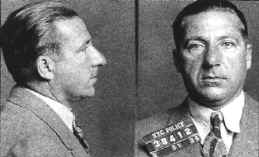 This is a mug shot for Frank Costello, a notorious and very influential mobster in the 1940's and '50's.
This is a mug shot for Frank Costello, a notorious and very influential mobster in the 1940's and '50's.In an earlier post, I took issue with a chapter in a 1983 book on computer crime. The chapter focused on the Mafia's involvement in computer crime; I said I think the author was wrong, both as to the state of affairs when he was writing and as to how cybercrime has evolved, at least to this point.
While I am sure the Mafia uses computers and the Internet in various ways, merely using a computer does not transform traditional criminal activity into cybercrime. It is, for example, increasingly common for drug dealers to use computers to keep track of their inventory, their sales and other matters. A drug dealer's using a computer for this purpose does not transform her drug-dealing into a cybercrime, just as a blackmailer's use of a computer to write the email or letter he sends to his victim does not transform his activity into cyber-blackmail.
Now, having said all that, I do happen to believe that cyberspace is, and will be, fertile ground for organized crime. . . . albeit a new type of organized crime.
In Organized Cybercrime, How Cyberspace May Affect the Structure of Criminal Relationships, 4 N.C. J. L. & Tech. 1 (2002), http://www.jolt.unc.edu/Vol4_I1/Web/Brenner-V4I1.pdf, I argue that cyberspace will give rise to new, more flexible arrays of organized criminal activity. As the article explains, the modern Mafia was "invented" in the early decades of the twentieth century and, for that reason, conformed to the organizational model that was influential in other sectors of society, such as commerce, industry and the military. The dominant model at that time, and for many years before, was the hierarchical organization, with fixed, rigidly-ordered relationships among the members of the organization. As I explain in the article, this type of organization is effective for orchestrating activity in the real-world.
I contend that this traditional, hierachical model is neither necessary nor particularly effective for orchestrating activity in the networked world of cyberspace. As I explain in the article, I think we will see (are, in fact, already seeing) fluid, shifting organizational patterns among cybercriminals.
As I also explain in the article, I think these more volatile forms of criminal organization will pose great challenges for law enforcement. In Frank Costello's time, the Mafia had stable, identifiable leadership and an equally stable, identifiable cadre of minions to carry out the directives of the leaders. This type of fixed, persistent organizational structure makes it relatively easy, over time, to identify critical personnel and map the organization's activities. This becomes much more difficult when criminal organizations become situational -- coalitions that develop to carry out particular activity and then disappear or merge into another evolving criminal coalition.



No comments:
Post a Comment